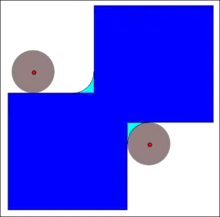闭运算
在數學形態學中,集合B對集合A的Closing是先dilation再用erosion。

如果選擇灰色圓盤當 B(kernel),對兩個深藍色的正方形做closing,會多出淺藍色的部分.
和分别表示dilation和erosion。
在影像處理中,closing和opening是用來對影像除噪,這邊通常A就是我們輸入的影像,B則是kernel。
特性
- Idempotent,即 .
- Increasing,如果 , 然後 .
- Extensive,即 .
- Translation invariant.
實作
這邊對binary image做closing的操作,kernel為5*5大小,4個角落被去掉。
closing不一定要先dilation一次再用erosion一次,也可以使用closing = dilation k times + erosion k times。
當想要closing的洞比較大時,可以使用更高的k次。
def dilation(img):
img1 = np.zeros((img.shape[0], img.shape[1]), dtype="int")
for i in range(img.shape[0]):
for j in range(img.shape[1]):
if img[i][j]>0:
row = i-2; col = j-2; # The octogonal 4-5-5-5-4 kernel
for w in range(5):
for h in range(5):
if ( w==0 and h==0 ) or ( w==0 and h==4 ) or ( w==4 and h==0 ) or ( w==4 and h==4 ):
continue
else:
i2 = row + w; j2 = col + h;
if i2 >= 0 and j2 >= 0 and i2 < img.shape[0] and j2 < img.shape[1]:
img1[i2][j2] = 255
return img1
def erosion(img):
img1 = np.zeros((img.shape[0], img.shape[1]), dtype="int")
for i in range(img.shape[0]):
for j in range(img.shape[1]):
flag = 0
row = i-2; col = j-2; # The octogonal 4-5-5-5-4 kernel
for w in range(5):
for h in range(5):
if ( w==0 and h==0 ) or ( w==0 and h==4 ) or ( w==4 and h==0 ) or ( w==4 and h==4 ):
continue
else:
i2 = row + w; j2 = col + h;
if i2 > 0 and j2 > 0 and i2 < img.shape[0] and j2 < img.shape[1]:
if img[i2][j2] == 0:
flag = 1
if flag == 0:
img1[i][j] = 255
return img1
def closing(img):
return erosion(dilation(img))
參考
This article is issued from Wikipedia. The text is licensed under Creative Commons - Attribution - Sharealike. Additional terms may apply for the media files.